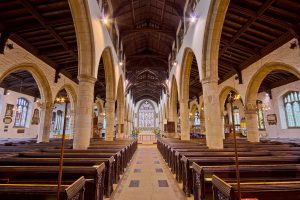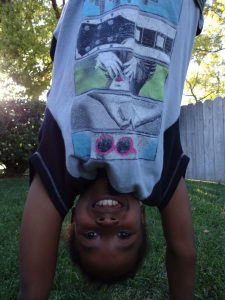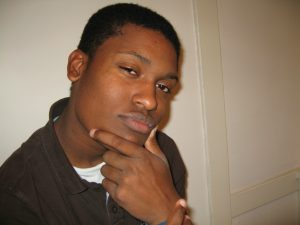Today’s entry is by guest blogger, Dr. Parnell Lovelace.
 I was reflecting this morning on my experience as a young child at the historic Shiloh Baptist Church in Sacramento, California. It is the oldest African American congregation west of the Rockies. In its prime period, it was considered to be an extremely “big” church. This term was more commonly used prior to such terminology as “mega-church.” Shiloh would fan the flames of social justice and biblical principles in my life and in the lives of noted individuals such as former Princeton professor, Dr. Cornell West. My parents were always were consistent in ensuring our timely arrival for Sunday services. However, for many years, I was ushered off to a children’s church gathering that was simultaneous with the one large morning worship service. I still recall telling my father, “I want to go to the big church.” I observed that the feelings of community, vibrancy, and empowerment seemed to be where nearly nine hundred people were gathering in the sanctuary down the hall from the children’s area. I wanted to be where things were BIG.
I was reflecting this morning on my experience as a young child at the historic Shiloh Baptist Church in Sacramento, California. It is the oldest African American congregation west of the Rockies. In its prime period, it was considered to be an extremely “big” church. This term was more commonly used prior to such terminology as “mega-church.” Shiloh would fan the flames of social justice and biblical principles in my life and in the lives of noted individuals such as former Princeton professor, Dr. Cornell West. My parents were always were consistent in ensuring our timely arrival for Sunday services. However, for many years, I was ushered off to a children’s church gathering that was simultaneous with the one large morning worship service. I still recall telling my father, “I want to go to the big church.” I observed that the feelings of community, vibrancy, and empowerment seemed to be where nearly nine hundred people were gathering in the sanctuary down the hall from the children’s area. I wanted to be where things were BIG.
Several years have passed, and I find my evaluation and appreciation of what constitutes a big church has changed. Yes, there is a unique phenomenon that occurs within congregations made up of five hundred or more people. However, there is a greater phenomenon that is occurring within the African American community as well as other communities that cannot be overlooked. There is interest in engaging small groups and small missional communities in ways that look very different than the image of a church with large numbers of people. These communities of five, ten, twelve, or fifteen people are redefining what makes a church big. Some specific characteristics of these groups are as follows:
1. Connection with other people without the requirement of formal membership
2. Commitment nurtured through connectivity versus various formalities
3. Emphasis on discipleship
4. Affirmation of the priesthood of the believer model
5. Opportunities for personal ministry using spiritual gifts
6. Intentional multiplication based upon necessity and desire to grow
7. Valuing and strengthening interpersonal relationships regardless of the number of people within the buildings
 I was once told as a young pastor, “Small groups will never work in an African American church.” Those who shared this thought felt that the experience found within the worship, preaching, and fellowship required the traditional gathering of everyone within the sanctuary. However, it is becoming clear that many congregations and home groups are proving that small groups and home churches are addressing a very real need among developing disciples. These groups are experiencing productivity and multiplication that far exceeds what more traditional structures have been able to measure. In some instances, new emerging pastors are reshaping the tapestry of ministry by embracing the small group, home church, or missional community approach. As I reflect back, the children’s church of twenty-five and my Sunday school of ten was a big church experience. Why? I grew and knew I was growing. That’s something to think about.
I was once told as a young pastor, “Small groups will never work in an African American church.” Those who shared this thought felt that the experience found within the worship, preaching, and fellowship required the traditional gathering of everyone within the sanctuary. However, it is becoming clear that many congregations and home groups are proving that small groups and home churches are addressing a very real need among developing disciples. These groups are experiencing productivity and multiplication that far exceeds what more traditional structures have been able to measure. In some instances, new emerging pastors are reshaping the tapestry of ministry by embracing the small group, home church, or missional community approach. As I reflect back, the children’s church of twenty-five and my Sunday school of ten was a big church experience. Why? I grew and knew I was growing. That’s something to think about.
Parnell M. Lovelace, Jr., MSW, D.Min.
Lovelace Leadership Connection
Rancho Cordova, California
figtree@centerofpraise.net
www.lovelaceleadership.org
As the successful founding pastor of 3,000-member Center of Praise Ministries in Sacramento, California, Parnell M. Lovelace, Jr. now serves as an apostolic strategist, merging the church with the social constructs of urban community. He holds a Bachelor of Social Work degree from Oral Roberts University, a Master of Social Work degree from the University of Oklahoma, a Master of Practical Theology degree from Oral Roberts University, and a D.Min. degree from Biola University (Talbot School of Theology). Dr. Lovelace currently serves on the Board of Trustees at William Jessup University and is a certified church consultant with the Society for Church Consulting.
